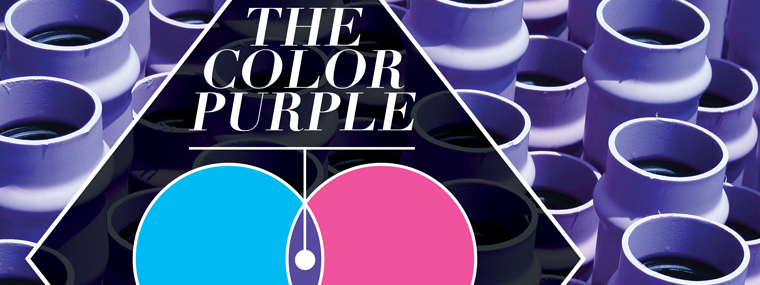
The Color Purple:Expanding Efforts in Water Reclamation
By Diane M. Calabrese / Published April 2015

Purple pipe—whether PVC or concrete—is just one indicator of the ever-expanding efforts in water reclamation. In the United States, all distribution pipe-carrying reclaimed water must be purple.
Running more than 600 pages, the EPA 2012 Guidelines for Water Reuse (www.watereuse.org/government-affairs/usepa-guidelines) provides a robust overview of what’s going on in water reuse, where it’s going on, and why it’s going on. Photos, including those of purple pipe, are beautiful, too.
The rationale for water reclamation is not something new to recent decades. Irrigation ditches and water storage methods (clay jugs, cisterns) go back millennia. (Average rainfall is not the same as actual rainfall.) In the 21st century, though, we know that reclamation is about more than ensuring an uninterrupted supply of potable water and freshwater for agriculture. It is also about conserving energy, and as a corollary, reducing emissions.
Nationwide, about one-half of freshwater goes to thermoelectric power-plant cooling. In some parts of the country, it is an even larger amount (Northeast 72: percent, MidAtlantic: 81 percent). We all tap into the power grid, so we use the coolant water indirectly. The populace’s direct draw of water from the public water supply accounts for a relatively modest 11 percent of water use.
Contractors have told us that it is sometimes difficult to persuade passersby that they make judicious use of water because of the highly visible nature of the water being used. Yet the professionals using pressure washers and waterjetting equipment are correct.
The amount of freshwater that U.S. industry and mining operations use on an annual basis is less than five percent of the total used. The total itself is generally measured as effluent, which was 32 billion gallons per day in 2012. Of that, seven to eight percent was reclaimed. As reclamation goes, the United States keeps accelerating its efforts. Some smaller nations are way ahead: Israel reuses 70 percent of the freshwater it generates domestically and Singapore reuses 30 percent.
Several of the nations that accomplish the most water reclamation are those that must desalinate water to have sufficient freshwater. Saudi Arabia is among them. Reclamation may save even more energy when freshwater is produced by desalination, an energy-consuming process.
Irrespective of how much water is being used, the general goal to do more and more with less and less contributes to a sustainable environment. It is also an attainable goal. One has only to consider the Inter-national Space Station (ISS) for exemplary results. The water recovery system deployed by NASA taps urine and humidity, a mix that is decontaminated for potable use. It can be done, in other words. There are all sorts of technologies refined in space that virtually scream for wider adoption. Among them are water-producing fuel cells.
Fuel cells (there are several kinds), which were used on the space shuttle, give off water as a byproduct. The Sabatier reaction (basically reduction of carbon dioxide to yield methane and water) that goes on in fuel cells has garnered wide attention on earth, where it may be a viable way to sequester carbon, and in space, where astronauts can make use of the water.
For a good primer on fuel cells, in order to better reflect on why they are not moving along faster, see the text produced by the Smithsonian Institution (American History) at americanhistory.si.edu/fuelcells/basics.htm.
Perspective from the Surface
The amount of water that pressure washing and waterjetting applications use may seem small or even negligible, but it still becomes wastewater post-application. And the regulations for disposal of wastewater, via collection and transport to a specified site or designated sewer system, must be followed.
Many large industries recycle water—that is, they remove contaminants and reuse the water again in industrial processes. The same approach is an option for contractors, although some may not make it their first choice.
“I think for most operators, it is more practical to capture the water on site and transport it to a place suitable for legal discharge…,” says Ron. W. Robarge, P.E., president of Spartan Manufacturing Corporation in Kernersville, NC. “A permit is usually required, but generally not hard to get. Or the contractor can treat the water to upgrade it enough to allow sanitary sewer discharge.”
What about the option of recycling the water on site? “Capturing, treating, and recycling wastewater back to pressure washers can create many issues,” says Robarge. Among the issues are those of maintaining high-quality results from the wash with recycled water and doing the recycling on site safely and at a cost that can be recouped. There may also be higher maintenance costs to the contractor because of additional equipment.
Robarge says it is generally more efficient to contain and capture wastewater for disposal than to recycle on site. His company makes portable equipment for suctioning water off any hard surface. He cautions that containing and capturing wastewater is just the first step in complying with environmental regulations. Follow through must occur.
Proper discharge meets all expectations and permitting requirements of the National Pollution Discharge Elimination System (NPDES), which is an outgrowth of the Clean Water Act of 1987.
Wastewater treatment is a complex subject. In the United States, public treatment facilities strive to eliminate or minimize everything from microorganisms to pharmaceutical products and toiletries in the water. In some countries, water is so scarce and poverty so severe that extensive filtering, other physical treatment, and chemical treatment are not done. Often recycled water just becomes potable water —contaminants and all.
Attention to water reclamation in the United States is not a new development. In 1954, President Eisenhower signed the Water Facilities Act, which put a focus on conservation and quality of water. More than 50 years earlier, the Reclamation Act of 1902 dealt especially with helping residents of Western states store water for irrigation or dry spells.
In its original sense, reclamation means to recover or take back, and in the 1902 Act that was the exact meaning conveyed. Arid lands would be reclaimed and brought to life as verdant, productive tracts of homes and fields.
Today, reclamation goes beyond the dictionary definition and water reclamation means to recover the water itself. Tied to water treatment efforts, though, are many industries that have reclaimed “waste” from water. Wastes have become useful products, such as those from flue dust.
Looking Forward
The Roman Empire did a remarkable job of keeping sewage and potable water separate. Sanitation was high. And it was all done without the technologies available to us in the 21st century.
We already know that using less water, such as by adjusting faucet heads and toilets, is a simple way to conserve water and energy. In many ways, society is catching up to our industry.
Moreover, members of the cleaning industry are finally being recognized as the “efficient users of water” they have long been, says Jerry McMillen, owner of Sirocco Performance Vacuums in El Cajon, CA. The ability the professionals in the industry have to “recycle for reuse” makes them especially efficient, he explains.
Members of the industry have grown accustomed to working with regulators. Complementing and supporting the genial interaction has been the development of focused and free education offered by organizations such as the United Association of Mobile Contract Cleaners, says McMillen.
“Contract cleaners are being trained and certified in environmental cleaning and several facets of instant capture cleaning,” explains McMillen. “This industry has become environmentally responsible and truly sustainable.” It has done so by responding to the societal and regulatory forces that have set expectations for methods, as well as by adhering to standards it has established for itself.
McMillen explains that the industry has long deserved recognition for the important work it does in maintaining clean living and working spaces, which are integral parts of a sustainable environment. Reclamation does just the opposite of cut into profits, explains McMillen. “It enhances the display of environmentally friendly cleaning.” Water reclamation tools “open the door to interior cleaning,” says McMillen. That adds opportunities. Good water reclamation tools eliminate the need for rinsing and make overspray a distant memory. They also do not add humidity to a room, so that drying speeds along.
How important is water reclamation? How important is water? The modern world supports as many people as it does (more than seven billion) because there is wide access to clean or relatively clean water and good or relatively good sanitation. Where there is neither, conditions are continuously improving.
A source of comfort, too, as people build fond memories of seashores, sea breezes, trout fishing, swimming, boating, and snow skiing. Water figures prominently in poetry, prose, and art. For many, the still waters of Psalm 23 come to mind first during stressful periods.
Eventually, it’s likely that waste and water will be decoupled. Just as on the ISS where there is used water and potable water, there will be used water (that may contain wastes slated for removal) and potable water. In other words, we are fully committed to doing the most with the least water (and energy).




